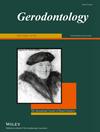Complete denture palatal rugae design impact on satisfaction and quality of life
Abstract
Objectives
To compare the impact of three complete denture palatal rugae designs on participants' satisfaction and oral-health-related quality of life.
Background
Complete dentures palatal rugea are usually polished to a smooth finish, which can affect the patient's adaptation. Roughening or keeping an opening in the rugae area to replicate the natural sensation of the palatal rugae has been suggested but lacks clinical evidence.
Methods
This randomised crossover trial included participants with complete dentures randomly allocated to six sequences. Each sequence alternated between polished, roughened, and open rugae designs. Participants evaluated general and domain-specific satisfaction (eating, taste, speaking, phonetics, and ease of cleaning) on a 100-mm visual analogue scale. They also completed the Oral Health Impact Profile for Edentulous Patients (OHIP-EDENT) and indicated their preferred design at the end. Repeated-measure ANOVA compared satisfaction, and one-way ANOVA with Tukey's test compared OHIP-EDENT scores.
Results
Forty-two participants were randomised. Seven dropped out. General satisfaction ratings were comparable for the polished (Mean = 80.2, SD = 19.7) and roughened designs (Mean = 79.5, SD = 20.2). However, the open design had a significantly lower satisfaction rating (Mean = 41.1, SD = 32.2). OHIP-EDENT scores for the open design (Mean = 44.9, SD = 17.5) were significantly worse than those for the polished (Mean = 36.1, SD = 12.7) and roughened designs (Mean = 36.2, SD = 13.3). Two-thirds of the participants chose the polished design. One-third chose the roughened design; of those, 83% were first-time denture wearers.
Conclusions
Complete dentures with polished and roughened rugae designs were perceived similarly. Both designs could be recommended based on the patient's preference. However, the open design should be avoided due to negative perception.

 求助内容:
求助内容: 应助结果提醒方式:
应助结果提醒方式:


